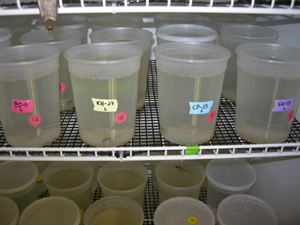Population genetPics of the wood frog, Rana sylvatica, and the spotted salamander, Ambystoma maculatum
Jonathan Richardson, Forestry Graduate Student


We are investigating the population genetics of wood frog, Rana sylvatica, and spotted salamander, Ambystoma maculatum, populations throughout Connecticut and Massachusetts. This study is using landscape genetic techniques and analyses to understand the influence of landscape features on amphibian dispersal, and the demographic and evolutionary consequences of varying levels of gene flow. This project is part of Jonathan Richardson’s dissertation research (Yale School of Forestry and Environment Studies Ph.D.).
Comparative phylogeography and coevolution of host, parasite, and vector in the Galápagos archipelago
 The Galápagos Islands present an extraordinary opportunity to examine patterns of migration and diversification of organisms. The geology of the islands is well understood and allows the timing and order of species colonization patterns to be inferred. In addition, islands differ in many ways, including size, habitat, and community composition, and this provides a backdrop for examining how different environments contribute to adaptation of various traits in radiating species. In this project, we plan to build on our existing knowledge of marine iguana evolutionary history by overlaying phylogeographic patterns of Hepatozoon parasites, and their potential arthropod vectors (mosquitoes, ticks). By examining the genetic patterns of host (marine iguanas), vector, and parasite, we can derive a greater understanding of how parasites disperse between populations. We also plan to use genetic techniques to collect data on parasite prevalence from all the major islands in order to determine how the ecology of each island contributes to the level of parasitism observed. For example, marine iguana populations differ in density, possibly due to local variation in levels of marine productivity. Population density could be one factor which impacts the ability of vectors to transmit parasites. In addition, the proximity of islands can also influence the ability of the host or vector to moved parasites between islands. This project is being developed in conjunction with Scott Glaberman, a postdoctoral associate in the lab, Henry Scott, a Master’s student in Forestry and Environmental Sciences program, as well as with scientists from Leeds University, Acadia University, and the Galápagos National Park.
The Galápagos Islands present an extraordinary opportunity to examine patterns of migration and diversification of organisms. The geology of the islands is well understood and allows the timing and order of species colonization patterns to be inferred. In addition, islands differ in many ways, including size, habitat, and community composition, and this provides a backdrop for examining how different environments contribute to adaptation of various traits in radiating species. In this project, we plan to build on our existing knowledge of marine iguana evolutionary history by overlaying phylogeographic patterns of Hepatozoon parasites, and their potential arthropod vectors (mosquitoes, ticks). By examining the genetic patterns of host (marine iguanas), vector, and parasite, we can derive a greater understanding of how parasites disperse between populations. We also plan to use genetic techniques to collect data on parasite prevalence from all the major islands in order to determine how the ecology of each island contributes to the level of parasitism observed. For example, marine iguana populations differ in density, possibly due to local variation in levels of marine productivity. Population density could be one factor which impacts the ability of vectors to transmit parasites. In addition, the proximity of islands can also influence the ability of the host or vector to moved parasites between islands. This project is being developed in conjunction with Scott Glaberman, a postdoctoral associate in the lab, Henry Scott, a Master’s student in Forestry and Environmental Sciences program, as well as with scientists from Leeds University, Acadia University, and the Galápagos National Park.

Microgeographic variation in growth and development rates of wood frog populations
Nisha Ligon, EEB Undergraduate Student


Investigation of the Eliurus antsingy complex: Species boundaries and phylogeography
Jean-Eric Rakotoarisoa, EEB Graduate student


